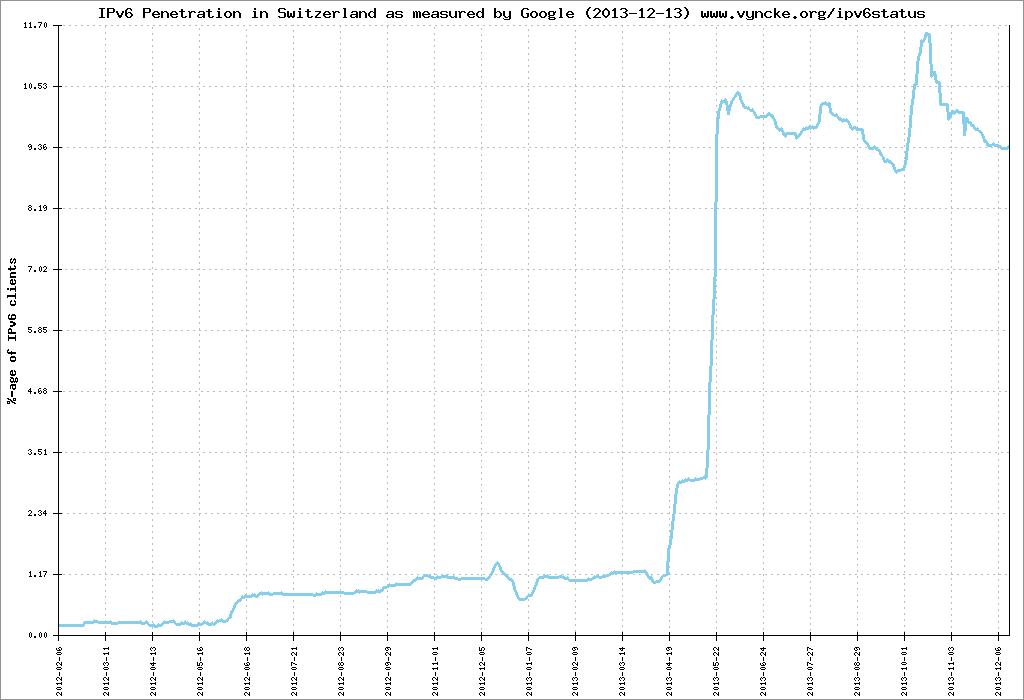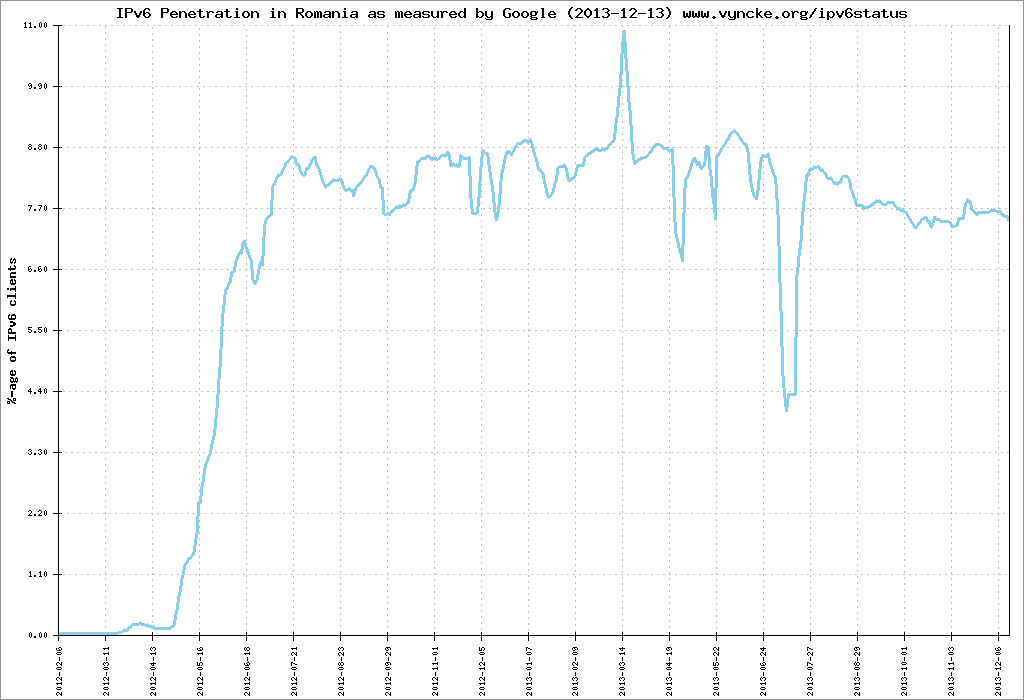It is pretty exciting to think about what is expected to happen in the ICT space over the next few years. On the other hand, is the network ready? Is IPv6 going to play a role in this space anytime soon?
I have asked Marco Misitano, Business Development Manager in my team about where are we on the transition to the new protocol and what we should expect coming in that space.
Marco, where do we stand today with IPv6?
IPv6 has come a long way! Not much happened until 2011, at the moment we finished IPv4 addresses. That is the moment when the snowball begins: we had the World IPv6 day in 2011 and that went so well in proving that IPv6 works at global scale, that in 2012 we had the World IPv6 Launch. That day many websites were enabled with the new protocol on top of the old, many home networking manufacturers provided IPv6 enabled out of the box and several ISPs started to provide IPv6 connectivity to residential users. All of this for good, not just for the day!
In the end, more has happened in the last 2/3 years than in the previous decade. IPv6 is among us: got a brand new smartphone or tablet? It’s there. Got a current OS on your laptop? It’s there. Accessing some content on the Internet? That’s likely available on IPv6 as well. Interacting with friends on Facebook, watching a video on Youtube? Available on v6! Residential subscriber? IPv6 being offered!
And, are these just generic trends or facts?
These are all hard trends. To make a few examples, Google is actually counting how many search requests it gets from IPv6 enabled browsers (that means v6 on devices and internet connectivity). Look what a trend we have, well over 2% of search queries worldwide are over IPv6:

If we look at specific countries some are significantly further along in their IPv6 transition! Belgium with over 4% of residential users on IPv6:

Switzerland recently passed the 10% threshold:

Germany, starting in September of last year, began a linear progression to over 5%

Romania also jumped from near zero to an impressive 7% in spring 2012:

We created 6lab.cisco.com/stats website to aggregate all these facts, including users, address allocation and more: browse to it and hover your mouse over your country and see how it compares to others!
What are the main drivers in the landscape?
Two main drivers: One is the Internet of Things / Internet of Everything. With that we are looking at unleashing a wave of innovation by connecting objects to each other. The scenarios this will allow are countless in multiple environments: healthcare, transportation, manufacturing, public sector and defense to name a few. Also in the consumer space the Internet of Things will automate, streamline and simplify tasks. Few examples: remote health monitoring or remote hospitalization, cattle monitoring, faster and more accurate door delivery (have you seen Amazon’s experiment of the Drone delivery? ), smart highways and more secure roads because of smart cars able to gather information from roads and other vehicles. Google recent Boston Dynamics and Nest acquisitions head exactly in the same direction: smart, connected objects.
These are all examples of objects talking with each other. While some communication may take place using short range communication, IP will play a key role as a platform. However the old IPv4 version simply won’t be able to keep pace with the expected growth of objects.
In six years from now we’ll have 50 billion devices, object, things, connected to the internet. With its space of nearly 4.3 billion addresses, IPv4 will NOT be enough. Holding to it will cause issues that will prevent internet evolution and become a barrier to innovation, not just in the IT space!
As opposed to that, IPv6, with its humongous address space already proved to be robust and scalable enough to make IoT happen: Internet of Things, Internet of Everything, that’s not going to happen without IPv6!
You said two drivers? What’s the other one?
The other is the growing smartphone adoption. Consumers are switching their traditional (voice and text only) mobile phone with a smartphone, with many areas of the world having more than 50% smartphone penetration (additional data for Europe only here). The characteristic of a smartphone is being always connected to the internet: that is an additional factor pushing for a larger address space, but it is not the only thing: we are starting to see 4G/LTE phones and in case you don’t know 4G has IPv6 as part of the specifications. So with smartphone we are contributing to grow the internet population and this contribution requires IPv6 to an increasingly larger extent.
And this smartphone trend, does it have any impact on the enterprise space, or is it purely a consumer trend?
It impacts enterprises as well. Let me make an example, if you’re a bank, mobile banking is a trend you are probably interested in. People like to do banking operations from mobile devices. The same people, sooner or later, will have a 4G/LTE smartphone. Remember we said IPv6 is part of these devices? This implies such smartphone will prefer IPv6 for connecting to the bank web front-end. So if the bank is interested in mobile banking, they should also be looking at offering services to IPv6 devices as well. T-Mobile decided to go IPv6 only for Android 4.4 devices, what if users of such devices want to do mobile banking?
In the future, not having an IPv6-enabled website will mean you might be losing business! This infographic from Arin makes a tremendous job at telling what is going to happen to those sticking with legacy IPv4.
Is there a killer application that runs only with IPv6?
How about… the Internet? The killer application is the Internet itself! Can you imagine living without it? Without all the information you might want or need that’s right in the palm of your hand with a smartphone, regardless of where you are? For me the answer is no, I couldn’t live without, and wouldn’t like its evolution to stop!
We are at an historical moment, where the Internet is really becoming ubiquitous, not just in terms of access, but also in terms of connected things, services and information availability, and IPv6 is a key enabler in this transition.
And let’s be clear there are no other solutions in sight for unleashing this wave of innovation. IPv6 is happening, no matter what.
Is it all about a larger address space, or is there more?
Actually there are a couple of positive side effects: with a larger address space there will be no need for address sharing mechanisms or NAT anymore, so we’ll be restoring the end to end connectivity that the IP protocol has been designed with.
In the end, this means better connectivity. It means web application working better and delivering the expected user experience all the time instead of misbehaving because of concurrent connections limited by NAT (see how google maps has issues when limiting the number of connections).
In an enterprise environment it means no more videoconferencing systems malfunctioning because of NAT, this is a frequent headache! And, as I hear the objection all the times, not having NAT doesn’t mean we are waiving security: NAT is not a security feature, all it gives is a false sense of security by hiding network topologies. Rest assured, the very same can be achieved with IPv6 without NAT.
With respect to megatrends, BYOD, video, cloud how is IPv6 relevant?
Very relevant! BYOD? People brings devices that have IPv6 onboard, if you want to manage those you better offer IPv6 connectivity. Otherwise how do you know how such devices will behave? Would they talk each other? Would they succeed in tunneling to the outside? To some extent in the BYOD example having IPv6 deployed means also better device manageability.
For video, we talked about end to end connectivity back in the game and that means a lot to video. Especially within the mobile video space, devices will start preferring IPv6 soon because of 4G so: better have content that is IPv6 ready right away!
Thinking of cloud it, is also about the better user experience of web applications and end-to-end connectivity, not to mention the datacenter side with all the addressing flexibility brought in by the new protocol because of its larger address space.
And finally Internet of Things! We’ve already touched on that and I’d like to conclude thinking about smart cities and all the possibilities to tie things together: roads, traffic control systems, cars, big data, citizens, public sector, health institutions, dynamic information… the future is closer, and IPv6 is here to make it happen!


CONNECT WITH US